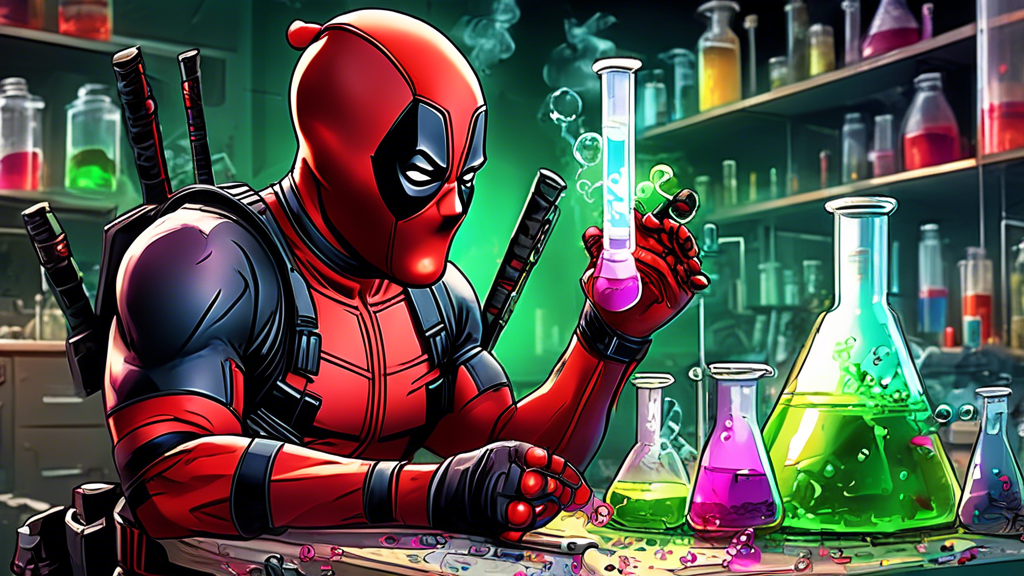Deadpool, the wisecracking antihero, is a fan favorite in the crowded world of comics and movies. His sharp wit and unconventional style make him stand out, but there’s more to Deadpool than attitude—his abilities have some wild science behind them. Exploring Deadpool’s science adds depth to his character and raises questions about how much could be real.
In this blog, we’ll break down the crazy aspects of Deadpool’s powers. We’ll explore his healing abilities, superhuman strength, agility, reflexes, and the idea of his supposed immortality. By comparing Deadpool’s abilities to real-world science, we’ll find connections in healing and regeneration. These connections might turn fiction into reality someday.
Let’s explore the science behind Deadpool. We’ll connect his over-the-top powers with modern science, showing how this character isn’t just entertaining and offers insight into where science might be headed.
Introduction to The Wild Science of Deadpool
Deadpool, the Merc with a Mouth, is one of Marvel’s most offbeat characters. His quick wit, fourth-wall-breaking, and over-the-top violence have greatly impacted pop culture. Ryan Reynolds’ portrayal skyrocketed Deadpool’s popularity, turning him into a household name.
His extraordinary abilities, raising interesting scientific questions, make Deadpool stand out. Though his powers seem fictional, they’ve intrigued Marvel fans and scientists alike. To understand Deadpool’s powers, we must explore his comic book origins and the science that might explain them.
This blend of fact and fiction deepens our appreciation for Deadpool and questions what’s scientifically possible. Deadpool’s regenerative healing factor allows him to recover from almost any injury, regenerating damaged tissue at mind-blowing speeds. Unlike regular people who heal slowly, Deadpool returns from fatal injuries, nearly invincible against poisons and diseases.
Deadpool’s superhuman strength, agility, and reflexes also play a huge role in his abilities. He can take on multiple opponents, perform crazy acrobatics, and react with lightning speed. These skills make him a formidable fighter, even among Marvel’s top heroes.
Deadpool’s immortality adds another layer of mystery. Thanks to Thanos’ curse, Deadpool can’t die, making him a fascinating case study of fiction vs. reality. While true immortality remains fantasy, Deadpool’s ongoing mutations and agelessness raise intriguing “what if?” scenarios.
The science behind Deadpool’s powers mixes biology, genetics, and physiology. Exploring Deadpool’s wild science reveals the fantastical and real-world principles behind his incredible abilities.
Make your next discovery where science meets surplus. Shop Obtainium

The Fictional Science Behind Deadpool’s Abilities
Deadpool, aka Wade Wilson, has incredible abilities that set him apart from typical superheroes. His powers center on his amazing healing factor and regeneration, which allow Deadpool to recover from injuries that would be fatal to others. He can regrow lost limbs and survive extreme traumas like decapitation, showing no limits.
How does his healing work? In the comics, Deadpool’s cells regenerate at lightning speed. In reality, humans can’t heal that fast, but Deadpool’s body constantly produces new cells, making him nearly indestructible. While fictional, this draws inspiration from animals with impressive regenerative abilities.
Deadpool’s superhuman strength, agility, and reflexes enhance his fighting skills. He performs wild feats like lifting massive objects and delivering bone-crushing punches. While the extent of his strength varies, he’s clearly more robust than average humans.
His agility and reflexes make Deadpool a nightmare in combat. He dodges bullets, performs acrobatic stunts, and outmaneuvers opponents, making him nearly unstoppable. Though exaggerated in comics, these abilities contribute to his formidable presence.
Deadpool’s immortality is perhaps his most intriguing power. Unlike others, Deadpool can’t die in the usual sense. His ongoing mutations, driven by his healing factor, make him immune to aging and diseases. His cells constantly renew, preventing his body from breaking down.
But how realistic is immortality? In reality, humans face cellular deterioration, where cells lose the ability to divide and regenerate. Deadpool’s mutations act like a cheat code, theoretically granting eternal life. While pure fantasy, it sparks conversations about human longevity.
Deadpool’s fictional science blends imagination with exaggerated biological concepts. His healing factor, strength, agility, reflexes, and immortality create a mysterious and pseudo-scientific character. Exploring these abilities enhances our understanding of Deadpool and the limits of human potential.
Make your next discovery where science meets surplus. Shop Obtainium

Real-World Science Comparisons and Possibilities
Comparison of Deadpool’s Regeneration to Actual Human and Animal Regenerative Capabilities
Deadpool’s regeneration is mind-blowing, but real-world animals have impressive healing abilities too. Salamanders can regrow lost limbs, tails, and even parts of their hearts and brains. Zebrafish can regenerate spinal cords, retinas, and fins, showcasing nature’s regeneration potential.
Humans aren’t as flashy in the healing department. We can regenerate liver tissue and heal minor wounds quickly, but nothing like salamanders or zebrafish. Scientists study these super-healers to boost our own regenerative abilities. Imagine a future where losing a limb isn’t permanent or critical organs repair as quickly as a scrape. It’s the kind of science that might one day bring us closer to Deadpool-level regeneration—pretty awesome to consider!
Insights from Current Medical Advancements Related to Healing and Cell Regeneration
The progress in regenerative medicine is remarkable, bringing us closer to Deadpool-like rapid healing. Stem cell therapy is one of the most exciting areas. Stem cells act as the body’s repair crew, transforming into different cell types to rebuild tissue. Scientists use stem cells to treat burns, spinal cord injuries, and heart disease. It’s like giving the body a boost to heal itself in new ways.
Gene editing, led by CRISPR, is another game-changer in medical science. This technology allows scientists to tweak genes, improving healing or fixing genetic defects. Imagine editing out harmful DNA or enhancing natural healing abilities—a biological cheat code. Clinical trials explore how these edits could treat genetic disorders and some cancers.
Tissue engineering is also advancing, with researchers growing lab biological tissues to replace damaged ones. Lab-grown skin, cartilage, and even tiny organs could soon be used in transplants. It’s like 3D printing for the body, creating custom parts that fit perfectly. These innovations could revolutionize medical treatments, moving us closer to Deadpool-like regeneration. Who knows? One day we might all have a bit of Deadpool’s healing factor!
Potential Scientific Explanations for Deadpool’s Extraordinary Abilities
Imagine if Deadpool’s rapid healing wasn’t just comic book fiction but a result of advanced genetic enhancements. His cells could have an accelerated ability to multiply and repair damage faster than anything. It’s as if his body permanently activates pathways controlling cell growth and tissue repair.
Supercharged genes might enable Deadpool’s continuous regeneration, similar to how some animals regenerate limbs without difficulty. Cracking this genetic code could unlock serious healing potential in humans. Imagine recovering from injuries at superhuman speeds with just a genetic switch!
Deadpool’s resistance to diseases and toxins might come from a hyper-efficient immune system, always ready to combat threats. Researchers are exploring ways to enhance human immunity with advanced vaccines and immune-modulating therapies. Engineering a lightning-fast immune system could drastically improve human resilience.
Deadpool’s continuous mutations may seem chaotic but represent an evolutionary advantage. In nature, beneficial mutations provide resistance to diseases or help creatures adapt to changes. Harnessing these mutations could revolutionize medical science and enhance human abilities.
While we’re not regenerating limbs or resisting poison like Deadpool, science is advancing in regeneration, stem cells, and gene editing. The Wild Science of Deadpool explores the overlap between comic book fantasies and real scientific advancements. Today’s science fiction could become tomorrow’s reality, and that’s an exciting prospect!
Make your next discovery where science meets surplus. Shop Obtainium

Bridging Fact and Fiction in The Wild Science of Deadpool
Throughout this exploration, we’ve uncovered the blend of fact and fiction that shapes Deadpool’s character. His extraordinary abilities, like rapid healing and superhuman strength, challenge scientific principles and push boundaries.
Deadpool’s accelerated healing and near-immortality remain fictional but advances in medicine, and genetics suggest some aspects could be achievable. His character sparks curiosity about human limits and future scientific breakthroughs.
Deadpool reminds us that the line between fiction and reality is always shifting. As science evolves, characters like Deadpool inspire us to imagine and explore new possibilities. The wild science of Deadpool is more than fantasy—it’s a catalyst for innovation, pushing us to consider a future where today’s fiction becomes tomorrow’s reality.
Make your next discovery where science meets surplus. Shop Obtainium

